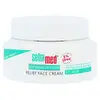What's inside
What's inside
 Key Ingredients
Key Ingredients

 Benefits
Benefits

 Concerns
Concerns

No concerns
 Ingredients Side-by-side
Ingredients Side-by-side

Water
Skin ConditioningCaprylic/Capric Triglyceride
MaskingUrea
BufferingPropylene Glycol
HumectantTocopheryl Acetate
AntioxidantGlyceryl Stearate Citrate
EmollientPanthenol
Skin ConditioningCetearyl Alcohol
EmollientAsiaticoside
AntioxidantAsiatic Acid
Skin ConditioningMadecassic Acid
Skin ConditioningBisabolol
MaskingCitric Acid
BufferingSodium Carbomer
Emulsion StabilisingSodium Hydroxide
BufferingParfum
MaskingBenzyl Alcohol
PerfumingPhenoxyethanol
PreservativeSodium Benzoate
MaskingWater
Skin ConditioningGlycerin
HumectantSqualane
EmollientPropanediol
SolventXylitylglucoside
HumectantSaccharide Isomerate
HumectantBisabolol
MaskingPropylene Glycol Dibenzoate
Skin ConditioningIsostearyl Alcohol
EmollientPentylene Glycol
Skin ConditioningCaprylyl Glycol
EmollientAcrylates/C10-30 Alkyl Acrylate Crosspolymer
Emulsion StabilisingAnhydroxylitol
HumectantSodium Acrylates Copolymer
Beta-Glucan
Skin ConditioningCalendula Officinalis Flower Oil
MaskingXylitol
HumectantLecithin
EmollientSodium Hydroxide
BufferingEthylhexylglycerin
Skin ConditioningAvena Sativa Kernel Extract
AbrasiveCitric Acid
BufferingHumulus Lupulus Extract
AntimicrobialHydrolyzed Glycosaminoglycans
HumectantCeramide 3
Skin ConditioningSodium Hyaluronate
HumectantSodium Citrate
BufferingHydrolyzed Hyaluronic Acid
HumectantHyaluronic Acid
HumectantSodium Hyaluronate Crosspolymer
HumectantTerminalia Chebula Fruit Extract
Skin ConditioningWater, Glycerin, Squalane, Propanediol, Xylitylglucoside, Saccharide Isomerate, Bisabolol, Propylene Glycol Dibenzoate, Isostearyl Alcohol, Pentylene Glycol, Caprylyl Glycol, Acrylates/C10-30 Alkyl Acrylate Crosspolymer, Anhydroxylitol, Sodium Acrylates Copolymer, Beta-Glucan, Calendula Officinalis Flower Oil, Xylitol, Lecithin, Sodium Hydroxide, Ethylhexylglycerin, Avena Sativa Kernel Extract, Citric Acid, Humulus Lupulus Extract, Hydrolyzed Glycosaminoglycans, Ceramide 3, Sodium Hyaluronate, Sodium Citrate, Hydrolyzed Hyaluronic Acid, Hyaluronic Acid, Sodium Hyaluronate Crosspolymer, Terminalia Chebula Fruit Extract
 Reviews
Reviews

Ingredients Explained
These ingredients are found in both products.
Ingredients higher up in an ingredient list are typically present in a larger amount.
Bisabolol is famous for its skin soothing properties. It does this by blocking inflammatory signals, helping to reduce your body's reaction to irritation.
This ingredient also interferes with the process of hyperpigmentation. This can help with reducing dark spots and uneven tone.
Bisabolol is an antioxidant. Antioxidants help fight free-radicals. Free-radicals are molecules that may damage your skin cells. By fighting these free-radicals, Bisabolol may slow down signs of aging.
Studies have shown Bisabolol to have antimicrobial properties and may be a fungicide. These properties help preserve a product's shelf life.
All these properties makes bisabolol a great skin barrier helper ingredient.
Bisabolol also helps the absorption of other ingredients.
Note: Synthetic Bisabolol has been shown to be less effective.
Learn more about BisabololCitric Acid is an alpha hydroxy acid (AHA) naturally found in citrus fruits like oranges, lemons, and limes.
Like other AHAs, citric acid can exfoliate skin by breaking down the bonds that hold dead skin cells together. This helps reveal smoother and brighter skin underneath.
However, this exfoliating effect only happens at high concentrations (20%) which can be hard to find in cosmetic products.
Due to this, citric acid is usually included in small amounts as a pH adjuster. This helps keep products slightly more acidic and compatible with skin's natural pH.
In skincare formulas, citric acid can:
While it can provide some skin benefits, research shows lactic acid and glycolic acid are generally more effective and less irritating exfoliants.
Most citric acid used in skincare today is made by fermenting sugars (usually from molasses). This synthetic version is identical to the natural citrus form but easier to stabilize and use in formulations.
Read more about some other popular AHA's here:
Learn more about Citric AcidSodium Hydroxide is also known as lye or caustic soda. It is used to adjust the pH of products; many ingredients require a specific pH to be effective.
In small amounts, sodium hydroxide is considered safe to use. However, large amounts may cause chemical burns due to its high alkaline.
Your skin has a natural pH and acid mantle. This acid mantle helps prevent harmful bacteria from breaking through. The acid mantle also helps keep your skin hydrated.
"Alkaline" refers to a high pH level. A low pH level would be considered acidic.
Learn more about Sodium HydroxideWater. It's the most common cosmetic ingredient of all. You'll usually see it at the top of ingredient lists, meaning that it makes up the largest part of the product.
So why is it so popular? Water most often acts as a solvent - this means that it helps dissolve other ingredients into the formulation.
You'll also recognize water as that liquid we all need to stay alive. If you see this, drink a glass of water. Stay hydrated!
Learn more about Water